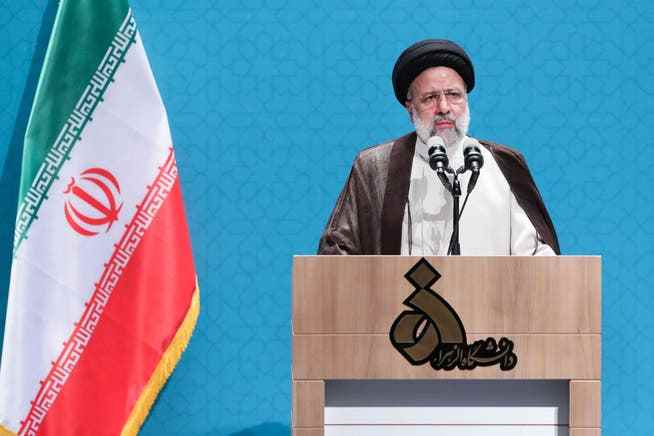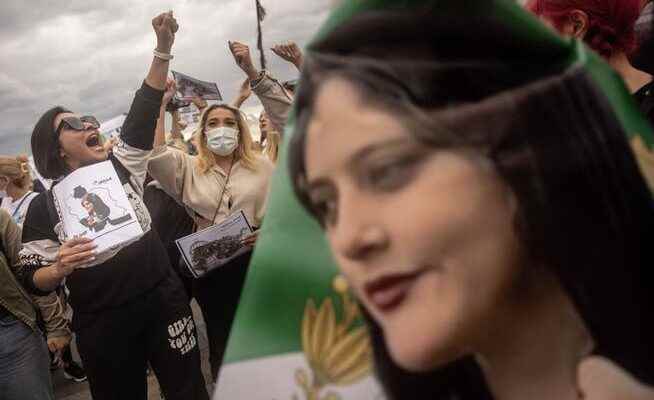Iranian Mahsa Amini died in police custody in mid-September. The reason for the arrest: She showed too much hair. Since then, Iranians have been protesting for more rights for women and, increasingly, for the overthrow of the regime.
Protesters hold signs and chant slogans during a demonstration against the death of Mahsa Amini in Istanbul.
The latest developments
- In response to European sanctions, Iran wants to put more than a dozen people and institutions on a “black list of terrorists”. Foreign Minister Hussein Amirabdollahian said this on Wednesday (October 19) in Tehran, state media reported.
background
What sparked the protests in Iran?
On September 16, Mahsa Amini, aged 22, from the Kurdish town of Saqez, died in morality police custody. Amini was on a sightseeing tour in Tehran when she was arrested by the moral police for wearing indecent clothing. The exact circumstances of her death are still unclear to this day. Authorities say Amini died due to a previous illness. However, her relatives are convinced that the police beat the young woman to death.
Since then, men and women in Iran have been taking to the streets in their thousands against the compulsory hijab and for more individual freedoms. The scale of the protests has not been seen for a long time since the Islamic Republic was proclaimed in 1979. The brutality with which security forces respond to the protests meets with the enormous courage of the Iranians.
The protests are repeatedly fueled by the actions of the police. One of the first victims was the mother of three, Minu Majidi, 52 years old and like Amini Kurdin. Majidi was shot dead during a demonstration in Kermanshah. Sarina Esmailzadeh, a 16-year-old YouTuber, was beaten to death with batons by police at a protest, according to Amnesty International.
What are Iranians protesting for?
Since the founding of the Islamic Republic, the headscarf has been closely linked to the political system ruled by the legal scholars. Women are required to wear a hijab to cover their hair and neck in public. Violations are punished by the religious and moral police.
Since the 1990s, women in Iran have been protesting against compulsory headscarves by showing more and more hair and allowing the scarf to move further and further back. Despite campaigns against the “badly veiled”, the regime has not been able to stop social change.

Protesters in Istanbul hold up a placard with a picture of Mahsa Amini, who was killed in Iran.
Under the slogan “Women, Life, Freedom”, the protesters not only stand up for their right to dress as they want. The protests are also directed against discriminatory inheritance, divorce and custody laws and against all the laws that disadvantage women in the labor market and in everyday life. The protests are additionally intensified by the anger about corruption, mismanagement and the threateningly rising cost of living.
How is the Iranian regime reacting?
The Iranian revolutionary leader Ali Khamenei has so far not responded to the people’s demands for freedom, but has blamed the USA and Israel for the protests. President Ebrahim Raisi and the state media also describe the protests as a staging by the country’s enemies.
The regime sees concessions as an expression of weakness and therefore, as usual, reacts harshly to the challenge. The Iranian security apparatus is trying to deter the demonstrators with violence. Almost 200 people are said to have been killed by the regime during the protests within a month.
The protests are also taking place online. Iranian women film themselves removing their headscarves in public and showing their hair. Many cut off a piece of their hair in protest. The regime reacted with internet blockades to prevent the demonstrators from networking and the dissemination of information.

Iranian President Ebrahim Raisi delivering a speech at Tehran’s Al-Zahra University in early October.
In addition, the regime denies journalists access to affected regions or arrests them. It affects well-known moderators in Tehran as well as unknown bloggers in the province. Information about the actions of the police and the situation during the protests is therefore difficult to get to the public.
The regime puts most of the arrested journalists and political activists in the notorious Evin prison. If they were not brutally beaten when they were arrested, they are at risk of violence there at the latest. Most of them are in solitary confinement in the interrogation block, where torture is the order of the day.
Why is Iran attacking Kurdish rebel groups?
Mahsa Amini came from Kurdistan, the historical settlement area of the Kurds, which stretches across the countries of Iran, Turkey, Syria and Iraq. Mahsa Amini’s real name was Zhina, but Iranian authorities do not recognize Kurdish names. The protests first began in September in Amini’s hometown of Saqez and from there spread to large parts of the country.
The powerful Revolutionary Guard blamed Kurdish “terrorists” and “separatists” in the Kurdish state in northern Iraq for the ongoing protests. For the Revolutionary Guard, it is a good excuse to attack Kurdish rebel groups’ bases with rockets, drones and artillery.
The Revolutionary Guard carried out its heaviest attack to date on September 28, when they fired rockets and kamikaze drones at the headquarters of three rebel groups near Suleimaniya, Koisanjak and the Kurdish regional capital Erbil. The attacks claimed at least 14 lives, including several civilians. Hundreds of Iranian Kurdish civilians enjoying UN refugee status have been displaced. Iran’s actions in northern Iraq are also causing tensions with the Americans, who have several bases there.
How are other countries reacting?
Parallel to the protests in Iran, people around the world are expressing their solidarity with the Iranians. In numerous cities from the USA to Turkey to Thailand, people are taking to the streets and demanding measures against Iran from politicians. Celebrities spread videos online in which they cut off a piece of their hair as a sign of solidarity.

A protester in London cuts her hair in solidarity with Iranian women.
The United States imposed sanctions on the Iranian vice squad just days after Amini’s death. Barely a month later, the EU followed suit and also imposed sanctions on the Iranian security apparatus. The foreign ministers decided on “restrictive measures” against eleven individuals and four organizations of the Islamic Republic. Among them are the moral police, the Basij militia, and the Revolutionary Guard’s cyber counter-squad.
Iran’s Communications Minister Issa Zarepur is also on the EU sanctions list. The hardliner had the internet switched off after Amini’s death. Specifically, the sanctions mean account closures and entry bans. The EU sees the scope for sanctions as limited because it does not want to torpedo the ongoing nuclear negotiations with Tehran. It is disputed whether more sanctions can bring the regime to give in at all.
Can the protesters overthrow the Iranian regime?
The shouts of “death to the dictator” heard during protests leave no doubt that the demonstrators are aiming for a system change. The protests are still too small to shake the regime. Even the “Green Movement”, which brought millions onto the streets after the falsified presidential election in 2009, didn’t make it. And this despite the fact that it was far better organized and could rely on established parties.
Nevertheless, the protests could become dangerous for the regime. Because the 83-year-old revolutionary leader Khamenei is in poor health. Should he die, there is no clear successor. In the event of Khamenei’s death, there is a risk of open succession disputes or a dangerous power vacuum. The population could take advantage of the momentum.
With the collaboration of Ulrich Schwerin and Inga Rogg.
